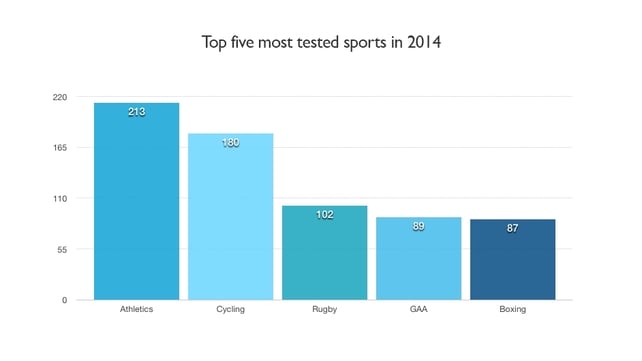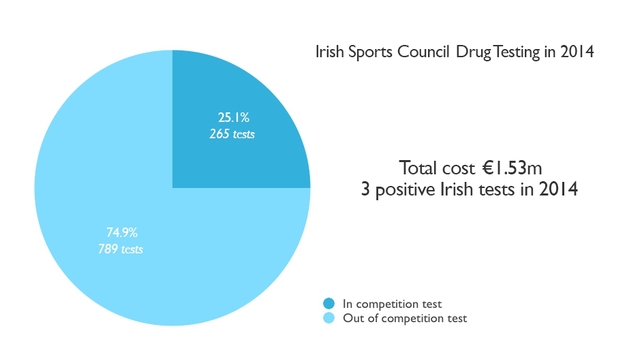Athletics is a sport in crisis following last weekend’s revelations that almost one third of medal winners in recent major championships returned suspicious blood results.
A Sunday Times investigation into leaked blood tests between 2001 and 2012 revealed that 800 out of 12,000 athletes - and nearly one in three medalists in endurance disciplines - had suspicious results, yet were not pursued by athletics’ world governing body, the IAAF.
Despite the IAAF’s claims that the Times piece was ‘sensationalist and confusing,’ the image of track and field is on the floor again. This latest development could see it fall below cycling, a sport still convulsed by regular drugs scandals, in terms of credibility.
The 100 metre final at the 1988 Seoul Olympics, notoriously won by Ben Johnson, was branded the Dirtiest Race in History but just last month, six of the seven athletes running the blue riband sprint event at the Lausanne Diamond League meet had either been banned for doping or had strong links to coaches with doping history.
Justin Gatlin, a two-time convicted cheat, won in Lausanne. To many his continued presence - and mind-bendingly fast times at the age of 33 - make a mockery of the sport.

But it’s not just athletics and cycling. Virtually every sport can be, and has been, corrupted by drug taking and it happens in this country too.
Monaghan’s Thomas Connolly this year became the first GAA player to return a positive test, earning himself a ban.
Sprinter Steven Colvert continues to protest his innocence as he begins a two-year suspension and amateur cyclist Ciaran Kelly has just started a four-year sanction for his drug transgression.
Almost every athlete across all sports banned for doping insists that they did no wrong, blaming contaminated supplements, sabotage and testing errors.
US sprinter Denis Mitchell blamed the ‘birthday treat’ he gave his wife - sex four times on the day of the test - for the presence of an increased level of testosterone in his system. That story was believed at the time too, though he eventually admitted habitual doping and involvement in the infamous Balco scandal.
Statistics show that the levels of positive tests in this country roughly mirrors international trends, three or four from the 1,000 or so tests carried out annually.
The Irish Sports Council (ISC) is the agency charged with keeping sport as clean as possible here and their Director of Participation and Ethics since 1998 is Dr Una May, herself a former international orienteering competitor.
According to May, athletes are willing to risk their health and wellbeing to use products not yet licensed fit for human consumption in order to gain an edge.
Micro-dosing is the latest trend to be detected among dopers, which is the regular use of extremely small amounts of a banned substance, such as Lance Armstrong’s favourite EPO, to boost performance yet evade detection. It has been proven to work and, done correctly, remains virtually undetectable.
On the ground, the ISC has around 50 testers carrying out urine and blood tests in sports as diverse as judo and hockey, motor cycling and swimming. Those disciplines with questionable histories, the likes of cycling and weightlifting, are targeted for additional scrutiny and testing.
In competition testing sees competitors tested straight after an event - or at least as soon as they can produce a sample, which isn’t always straightforward - and out of competition, which can be done at any time.

“It’s gas because in the two hours before a fight you might go to the toilet ten times because you’re drinking so much trying to stay hydrated, but once you start your warm-up, the water leaves your body and it might be two hours before you can provide a sample,” explained Irish Olympic boxer and Rio 2016 hopeful Darren O’Neill.”
“Out of competition means they come out to your home or where you’re training, or wherever you’ve told them you’ll be. You get a form and you’re asked to fill out where you’re going to be every day and give a 60 minute slot where you can be tested.
"For the lads at least, it’s pants to the knees and shirt up so everything can be seen" - Darren O'Neill
“We don’t know where we’ll be a lot of the time. We had a training camp in Azerbaijan and I didn’t know what hotel I’d be staying in or what the room number would be until I was there. Same with the athletes’ village at the European Games - you don’t know until you arrive.
“I always write down in the additional notes section to avoid testing at the weekend where possible because I may be in transit between Dublin and Kilkenny. But I always seem to be tested at weekends and that drives me mental.
“If it’s a urine test there’s two people and if it’s blood there’s three,” continued O’Neill. “You sit down and do the paperwork and no matter how many times you’ve seen the tester you have to provide some form of ID like a passport or driving license.
“You get to pick your vessels from a selection they have, one for collection and the other for storage. Then you go to the bathroom with a tester and, for the lads at least, it’s pants to the knees and shirt up so everything can be seen.Then you have to provide a 90ml sample.”

The vast majority of athletes say they believe in clean sport and they’re happy to be tested wherever and whenever in order to assure that. However, most acknowledge frustration with having to provide a sample whilst dehydrated and about having to fill out the a ‘whereabouts form’ for out of competition testing.
Whereabouts means an athlete has to give testers a one hour slot every day for three months saying exactly where they’ll be.
“Definitely it’s something I’m happy to do and I hope it continues and I hope there’s not a whole lot of controversy around it,” said current Hurler of the Year Richie Hogan, who has been tested five times in his career, a high number within the GAA. Unlike in most other sports, GAA players don’t have to fill out a whereabouts form, with the county board instead providing details of training times and venues in order to facilitate out of competition tests.
“I remember one year after an All-Ireland semi-final a good few years ago, James McGarry and I were running around Croke Park at 9pm at night trying to get the water flowing back around the system after a game that afternoon.
“And neither of us had even been playing! It’s a strange thing, but it’s something that has to be done.”
May says that all athletes should be informed of their test results , positive or negative, once they are communicated from the testing laboratory in Cologne, Germany, though the ISC and then the sport’s governing body.
Though this isn’t always the case, as O’Neill explains: “Generally you’re not told, though occasionally I have gotten a text message to say I tested negative. I remember the first one I got, it gave me the fright of my life because it was the first time I’d gotten a text off them in ten years and I didn’t know what they were going to say to me!”
Athletes are told never to take anything without consulting a doctor with anti-doping experience first. Any dietary supplements, such as protein drinks, should be OKed too and batch numbers recorded should their be any adverse findings, as contaminated supplements have led to positive tests in the past.
They also have access to a free ISC app which allows them to search any medicine, and whether or not it’s banned, ailment or treatment. The most searched medicines are, probably unsurprisingly, popular cold remedies and pain-killers like Lemsip, Nurofen, Panadol and Sudafed.
A report-doping-line has also been launched, allowing anyone to report evidence or suspicions they have of doping transgressions to the ISC and they can do so anonymously if they wish.
Waterford’s Thomas Barr has begun moving in rarified company, with the Irish 400 metre hurdles record holder and newly minted World Student Games champion having recently made his debut on the Diamond League circuit.
He hates that the sport he loves is constantly, and rightly, under suspicion due to the lawless actions of fame and success hungry cheats.
The ISC has funded international research into doping and now works with Health Products Regulatory Authority, the Garda National Drugs Unit and with Customs in a bid to combat doping in sport.
Yet the dopers, their doctors, scientists and their backers, continue to come up with new ways to stay ahead of the authorities.
New research even suggests that athletes who have taken drugs continue to benefit from their activities years after they have stopped using, sometimes after serving a ban, with elevated levels of performance.
“What’s to say that they aren’t still reaping the benefit of when they were on drugs?” asked Barr.
“They could have been taking testosterone for two, three years, take the ban and surely there’s still something in their system. Justin Gatlin and Tyson Gay are no spring chickens and they’re still running faster than they were when they were on drugs.
“It does pose questions and it’s not good for the sport to have that history there in the sport. Talk to anyone, even people who don’t watch athletics, and they’ll know ‘oh yeah, he was on drugs’. There’s no enjoyment in it in that respect.”
May remains optimistic that significant gains can be made however, to turn the tide in favour of clean sport.
Testing rates in Irish sport in 2014
Athletics - 213 tests
20 in competition
193 out of competition (85 blood tests)
Cycling - 180 tests
38 in competition
142 out of competition (61 blood tests)
Rugby - 102 tests
0 in competition
102 out of competition (40 blood tests)
GAA - 89 tests
44 in competition
45 out of competition (0 blood tests)
Boxing - 87 tests
8 in competition
79 out of competition (30 blood tests)
All video shot and edited on iPhone 6+


